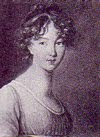
A Spinster in a Neo-Classical Sitting Room Interior, c. 1835
Russian School (19th Century)
Watercolour with heightening on paper
Private Collection
Source: Charles Plante Fine Arts / The Bridgeman Art Library,
Image Number: CJP107277
This blog is primarily about knitting in an historical context – reproduction of items from the past, techniques, patterns or not, artwork about historical knitting. I must comment, however, on contemporary knitting history, namely, Ravelry, which is making knitting history every day. Not everyone who reads this blog is a member of Ravelry but I would hazard a guess that nearly everyone has, at least, heard of Ravelry. It is a phenomenon in itself and a gateway to a world of knitters, crocheters, spinners, designers, breeders and anyone who creates garments and objects out of some sort of string be it made from wool to plastic bags and heaven knows what else or is just interested in the diversity of materials and creations. There is no limit to the span of the outputs of its members be they multi-talented or a complete beginner in the medium of their choice. I cannot even imagine how many “Groups” there are, let alone the gamut of topics, fibre and non-fibre based, which bounce back and forth and from all over the planet, and beyond, perhaps, for all I know!
On February 29, 2012, the two-millionth Raveler signed up! So much for all of those folk out there who smile at me, often condescendingly, and say how nice it is that I am still doing a dying art which no one seems to do anymore these days, and how sad it is to lose it, etc., etc. (I get that response when quilting or stitching in public, too.) One more piece of ammunition in my response kit bag now. One more reason to think about all of the interesting people I have “met” from so many different locations, who share my passion for textiles, offer assistance and advice, and share their ideas, comments and laughter online. Most of all, one more reason to thank the developers of Ravelry who have given us a place to meet, discuss and visually track and share our projects, stashes, book and pattern collections, and so very much more. They continue to make a terrific site better and better all of the time, and I look forward to celebrating the three-millionth member!



